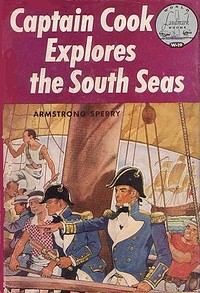Captain Cook Explores the South Seas by Armstrong Sperry. World Landmark #19.
The book’s title is a bit of a misnomer: James Cook didn’t explore just the South Seas. He went almost everywhere: starting in England, then Canada, the Arctic, the Antarctic, the Sandwich Islands (Hawaii), Tahiti, Cape Horn, the Cape of Good Hope, Alaska, Melanesia, Micronesia, New Zealand, Australia, and all points in between. He went on three voyages of exploration, and boy, did he explore. And he started out as a farmer’s son and ended up as captain of his own ship and leader of the three afore-mentioned expeditions, gaining fame and glory and all sorts of scientific information, maps, charts, botanic specimens, paintings, and other discoveries on behalf of the Royal Society and the British Admiralty.
All of the Landmark books that I have read are well written, but I think this one is one of the best in terms of excellent writing and storytelling. Cook’s adventurous life and rags to riches story lends itself to the creation of an adventure story, and Sperry’s telling of the story does not disappoint. He begins the tale as thirteen year old James Cook leaves his home to take up an apprenticeship that will bring him near the sea:
“That August morning in the year 1741, the early sun was as bright as a promise of good fortune. It cast a light of gold over the rolling moors of Yorkshire, on fat sheep grazing in the fields. It lay warm as a blessing on the shoulders of the boy who followed so eagerly an empty road that stretched forever away from Great Ayton.
Mark that boy well, Reader! For young James Cook–tall for his thirteen summers, and with all his belongings swinging in a bundle at the end of a stick–had set forth on a great adventure. Although in years to come he was to travel farther over the earth’s surface than any man before him, perhaps this first youthful journey was the most momentous of all. It set the pattern of his future.”
Armstrong Sperry, author of the Newbery award story, Call It Courage, traveled in the South Seas himself, and learned both French and Tahitian. Sperry was also a Navy veteran and interested in all things nautical, and he was a talented artist whose illustrations for this book about Captain Cook are exquisite and fully supportive of the lively narrative text. Sperry wrote two other books for the Landmark series, The Voyages of Christopher Columbus and John Paul Jones, Fighting Sailor as well as several other nautical-themed fiction books for children. I am eager to read some of his other books since the writing in this one is so very good.
A couple of content considerations: Sperry describes the “savages”, both of North America (Canada) and of the Pacific islands, in mostly unflattering terms. Cook described the islanders in particular as primitive, thieving, and unhygienic, reserving the term “handsome” for the Tahitians and the Hawaiians only. So that’s how Sperry describes them. And the life and travels of Captain James Cook do not end well. He gets into a dispute, perhaps a misunderstanding, with the king and people of the Sandwich Islands (Hawaii), and he is killed on the beach by a Hawaiian war club wielded by one of the king’s warriors.
Despite the content considerations, I highly recommend Captain Cook Explores the South Seas, maybe along with a book told more from the perspective of the native islanders. The Last Princess, The Story of Princess Ka’iulani of Hawaii by Fay Stanley is one possibility. Another Landmark about Hawaii (which I haven’t read) is Hawaii, Gem of the Pacific by Oscar Lewis.









